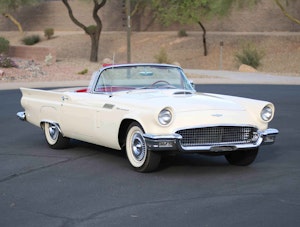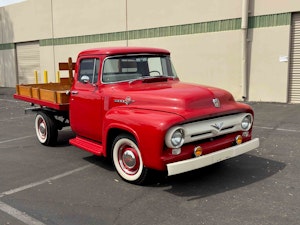Media | Articles
Presidential Car Names
When it comes to cars, few want to buy a Lincoln, let alone a Washington or Bush
You’d think that naming a car for a president might spark name recognition, and thus sales. Yet few cars named for U.S. presidents have proven successful.
Consider Washington, a name often associated with character and strength. While Washington may have been first in war, first in peace and first in the hearts of his countrymen, it wasn’t so when it came to car sales.
Two companies based in Washington, D.C., one formed in 1899, the other in 1901, were able to raise financial backing but never produced a car.
A gent from Chicago who shared his name with the father of our country made another attempt in 1902. However, one guesses that Washington and his army could cross the ice-choked Delaware River faster than this car could travel across town. Its speed was a mere 1 mph, due to the car’s 8-ton curb weight.
Marketplace
Buy and sell classics with confidence
Thankfully, the president’s name lay dormant until 1909, when the Carter Motor Corp., located northeast of the nation’s capital, in Hyattsville, Md., launched the Washington A-1. Offered in two body styles, the A-1 was powered by a 30-horsepower, four-cylinder engine and proved successful enough that the company added the A-2 with 35 horsepower and the B-1 with 45 horsepower the following year. It lasted until 1912, when Carter filed for bankruptcy.
If the failure of Carter the company seems to mimic the president of the same name, there’s a reason for that: oddball thinking. The company’s first car, the 1907 Carter Two-Engine, was built with a spare engine in case the first one failed. By comparison, the Washington was strikingly normal, even if most of the factory workers building the car were college students.
This failure wasn’t enough to deter two separate Ohio companies formed using the Washington name: one located in Cleveland, the other in Eaton, just west of Dayton. The Cleveland company never built a car; the Eaton company did. And, predictably, few buyers wanted the Washington Motor Co.’s six-cylinder, gasoline-powered passenger car. Production rarely surpassed five cars a week — the minimum needed to remain profitable.
In desperation, in 1923, the company decided that introducing a steam-powered car was the answer. Never mind that steam’s popularity was losing steam. Miraculously, financing was secured and it is rumored three buyers were found. A year later, the car advertised as “The Ideal of a Nation” faded from view when this company, like others named for our first president, went bankrupt.
Of course, it’s not just Washington’s name that proved sales-proof.
Madison Motors Co. of Anderson, Ind. was named in honor of our fourth president and produced the Dolly Madison between 1915 and 1919. Despite a 22-horsepower, 6-cylinder engine, it lacked the appeal of the snack cake (and first lady) of the same name.
Better known is the 1929 Roosevelt, named after Theodore Roosevelt by luxury carmaker Marmon of Indianapolis. It was affordably priced at less than $1,000 yet proved as popular as the Bull Moose Party.
Other presidential surnames show up coincidentally as car company names, including Bush, Cleveland, Clinton, Ford, Harrison, Hoover, Jackson, Jefferson, Johnson, Kennedy, McKinley, Monroe, Pierce, Taft and Taylor. Few, if any, met with success.
And so, we are left with Lincoln, named after the president by company founder Henry Leland in 1920. Yet Lincoln too almost met the same plight as Washington, Madison and many others. While the car’s engineering was excellent, Leland put his son-in-law in charge of styling.
Bad idea.
By 1922, the Lincoln Motor Co. was in trouble. Henry Ford bought it for $8 million.
These days, the marque is hanging on, and Ford officials maintain the company remains committed to the brand. Yet history suggests its success is not assured.










